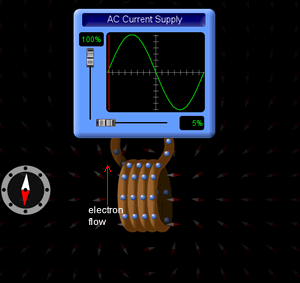A transformer is based on the fact that when an AC current flows through a wire, it generates a magnetic field commonly known as a “magnetic flux” all around it. The strength of this magnetic field is directly related to the size of the electric current and is known as the magnetic flux density. So the bigger the current the greater the magnetic flux density.

Now if another wire comes close to a wire with an AC current flowing through it , it to will experience an electric current flowing through it.
So if we put a second coil of wire next to the first one, and send a fluctuating electric current into the first coil, we will create an electric current and voltage in the second wire.
The current in the first coil is usually called the primary current and the current in the second wire is known as the secondary current.

In actual fact what happens is an electric current is passed through empty space from one coil, the primary coil, of wire to another, the secondary coil. This is called electromagnetic induction because the current in the first coil induces a current in the second coil.

i enjoyed the site more than any site in engineering i have come across especially details in instrumentation. I need more on Sensors